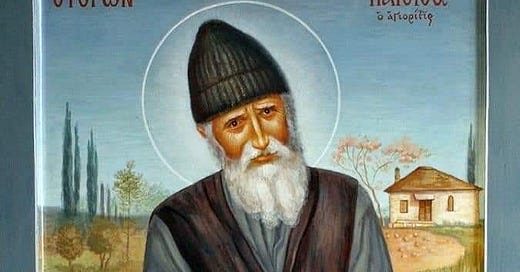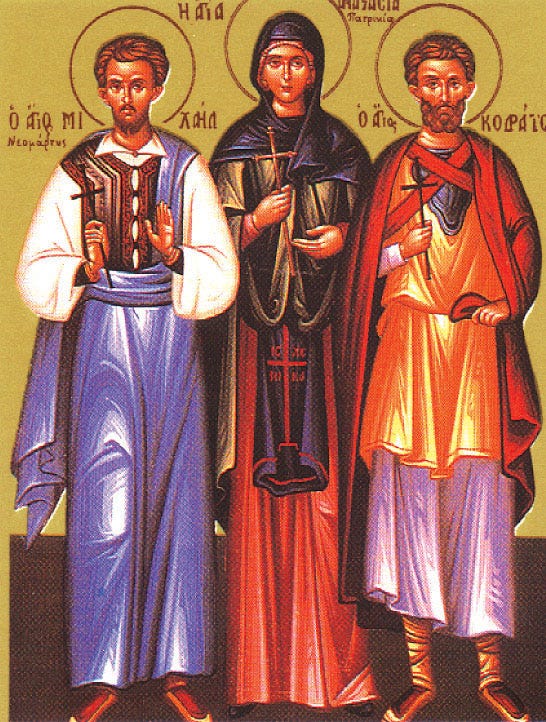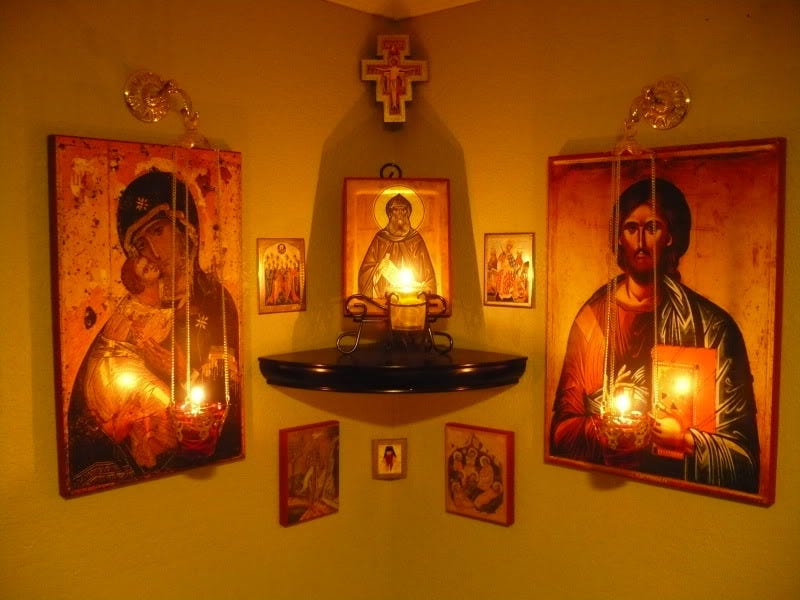"Pride is a shameful and terrifying thing, which even turned angels into demons! It drove us from Paradise to earth, and now it wants to send us from earth to hell. An inattentive person can be proud even while simply lying in bed."
+ St. Paisios the Athonite
Isaiah 4:2-5:7 (6th Hour)
2 In that day the Branch of the Lord shall be beautiful and glorious; and the fruit of the earth shall be excellent and appealing for those of Israel who have escaped.
3 And it shall come to pass that he who is left in Zion and remains in Jerusalem will be called holy – everyone who is recorded among the living in Jerusalem.
4 When the Lord has washed away the filth of the daughters of Zion, and purged the blood of Jerusalem from her midst, by the spirit of judgment and by the spirit of burning,
5 then the Lord will create above every dwelling place of Mount Zion, and above her assemblies, a cloud and smoke by day and the shining of a flaming fire by night. For over all the glory there will be a covering.
6 And there will be a tabernacle for shade in the daytime from the heat, for a place of refuge, and for a shelter from storm and rain.
1 Now let me sing to my Well-beloved a song of my Beloved regarding His vineyard: My Well-beloved has a vineyard on a very fruitful hill.
2 He dug it up and cleared out its stones, and planted it with the choicest vine. He built a tower in its midst, and also made a winepress in it; so He expected it to bring forth good grapes, but it brought forth wild grapes.
3 “And now, O inhabitants of Jerusalem and men of Judah, Judge, please, between Me and My vineyard.
4 What more could have been done to My vineyard that I have not done in it? Why then, when I expected it to bring forth good grapes, did it bring forth wild grapes?
5 And now, please let Me tell you what I will do to My vineyard: I will take away its hedge, and it shall be burned; and break down its wall, and it shall be trampled down.
6 I will lay it waste; it shall not be pruned or dug, but there shall come up briers and thorns. I will also command the clouds that they rain no rain on it.”
7 For the vineyard of the Lord of hosts is the house of Israel, and the men of Judah are His pleasant plant. He looked for justice, but behold, oppression; for righteousness, but behold, a cry for help.
Genesis 3:21-4:7 (Vespers, 1st reading)
21 Also for Adam and his wife the Lord God made tunics of skin, and clothed them.
22 Then the Lord God said, “Behold, the man has become like one of Us, to know good and evil. And now, lest he put out his hand and take also of the tree of life, and eat, and live forever” –
23 therefore the Lord God sent him out of the garden of Eden to till the ground from which he was taken.
24 So He drove out the man; and He placed cherubim at the east of the garden of Eden, and a flaming sword which turned every way, to guard the way to the tree of life.
1 Now Adam knew Eve his wife, and she conceived and bore Cain, and said, “I have acquired a man from the Lord.”
2 Then she bore again, this time his brother Abel. Now Abel was a keeper of sheep, but Cain was a tiller of the ground.
3 And in the process of time it came to pass that Cain brought an offering of the fruit of the ground to the Lord.
4 Abel also brought of the firstborn of his flock and of their fat. And the Lord respected Abel and his offering,
5 but He did not respect Cain and his offering. And Cain was very angry, and his countenance fell.
6 So the Lord said to Cain, “Why are you angry? And why has your countenance fallen?
7 If you do well, will you not be accepted? And if you do not do well, sin lies at the door. And its desire is for you, but you should rule over it.”
Saint Anastasia the Patrician of Alexandria
Saint Anastasia the Patrician of Alexandria lived in Constantinople and was descended from an aristocratic family. She was an image of virtue, and she enjoyed the great esteem of the emperor Justinian (527-565). Widowed at a young age, Anastasia decided to leave the world and save her soul far from the bustle of the capital. She secretly left Constantinople and went to Alexandria. She founded a small monastery not far from the city, and devoted herself entirely to God.
Several years later, the emperor Justinian was widowed and decided to search for Anastasia and marry her. As soon as she learned of this, Saint Anastasia journeyed to a remote skete to ask Abba Daniel (March 18) for help.
In order to safeguard Anastasia, the Elder dressed her in a man’s monastic garb and called her the eunuch Anastasius. Having settled her in one of the very remote caves, the Elder gave her a Rule of prayer and ordered her never to leave the cave and to receive no one. Only one monk knew of this place. His obedience was to bring a small portion of bread and a pitcher of water to the cave once a week, leaving it at the entrance. The nun Anastasia dwelt in seclusion for twenty-eight years. Everyone believed that it was the eunuch Anastasius who lived in the cave.
The Lord revealed to her the day of her death. Having learned of her approaching death, she wrote several words for Abba Daniel on a potsherd and placed it at the entrance to the cave. The Elder came quickly and brought everything necessary for her burial. He found the holy ascetic still alive, and he confessed and communed her with the Holy Mysteries. At Abba Daniel’s request, Saint Anastasia blessed him and the monk accompanying him. With the words: “Lord, into Thy hands I commend my spirit,” the saint died in peace (ca. 567-568).
When the grave was prepared, the Elder gave his disciple his outer garment and ordered him to dress the deceased “brother” in it. As he was putting on the rassa, the monk noticed that she was a woman, but he did not dare to say anything. However, when they returned to the monastery after they buried the nun, the disciple asked Abba Daniel whether he knew the “brother” was a woman, and the Elder related to the young monk the life of Saint Anastasia. Later, the abba’s narrative was written down and received wide acclaim.
The relics of Saint Anastasia were transferred to Constantinople in the year 1200, and put not far from the church of Hagia Sophia.
The theology of the holy icons [Part 2]
By Hierodeacon Rafael Misiaoulis, Theologian
The icon in Orthodoxy teaches the mystery of the incarnation of the Son and Word of God. Refusal to venerate and honor an icon of him is tantamount to denying his incarnation. Moreover, the saints are depicted and venerated because they’re members of the body of Christ and have the grace of God within them. The icons function as bearers of divine grace, in the same manner as human nature put into practice the divine characteristics of the Word. This is how icons work wonders [13].
In the 8th century, a theological and political conflict arose in Byzantium regarding the veneration of Christian icons. This conflict divided the inhabitants of the empire into iconoclasts and iconodules [opponents, and supporters, of icons].
Iconoclasm was a heresy against the dogma of the incarnation of the Word and therefore against the mystery of the divine dispensation. This had an immediate impact on the life and theology of the Church.
The iconoclasts claimed that God is ‘undepictable’, thereby undermining and casting doubt on the historical incarnation of the Son and Word of God. But Saint John the Damascan declared: ‘I do not depict the invisible Godhead, but God’s flesh as it was seen’ [14]. The same truth, which was formulated dogmatically by the holy Synods and by the Fathers, is depicted in images by the iconographers. For the iconoclasts, icons were, in fact, idols, because these people saw only the wood and paint and were unable to rise to the task of gazing spiritually upon the living beings portrayed in the icons.
Saint John tells us: ‘Therefore an icon is a likeness of someone and a sample and impression which shows the person portrayed, but in no way resembles the original in his or her entirety…’ [15]. Explaining the reason for the existence of icons, he has this to say: ‘they are to bring people to knowledge and to manifest and announce to them what is hidden…’ [16].
Saint John the Damascan was one of the most important supporters of icons and devoted three treatises to the issue [17], as well as a chapter of his work The Exact Exposition of the Orthodox Faith [18]. Another was Saint Theodore the Studite who, during the time when he was imprisoned, wrote a great many disquisitions in favor of icons, though the interest of scholars has largely centered on his three Polemical Discourses.
Against the iconoclasts, supporters of the images argued: a) that the icon itself and the material of which it is made isn’t honored, as would be the case with an idol, but rather that any honor paid goes to the prototype [i.e. the person depicted]; and b) the person depicted isn’t the fruit of human imagination, as are idols, but was a real person and, as such, can be portrayed.
In 746, Emperor Leo III published the first decree envisaging the destruction of all icons and also forbidding veneration of and prayers to the saints. Until 741when Leo died, his policy was relatively moderate, and it seems that the prohibition and removal of the icons weren’t strictly enforced. His son and successor, Constantine V, was much harsher. He unleashed a persecution against the icons and their monastic supporters, convoking the Synod of Hieria, by which religious depictions were banned. Monks and nuns were forced into marriage and many monasteries were taken over by the state.
This great turbulence which afflicted the body of the Church lasted some 116 years, though not continuously. During that period, the great spiritual personalities of the age, such as Saint John the Damascan, Patriarch Tarasios of Constantinople, Theodore the Studite and Pope Hadrian of Rome, all raised their voices and stood their ground without hesitation, fear or any thought as to what other people might say. Through their theology the error of the iconoclasts was exposed and it was possible to convene the 7th Ecumenical Synod in 787, in Constantinople, with Patriarch Tarasios presiding. This Synod revoked the Synod of 754, under Constantine V, anathematized the heretic iconoclasts and enshrined Orthodox teaching regarding the holy icons. On 23 October, 787, at a triumphant session in the Great Hall near the palace, the resolutions of the synod were ratified and signed by Empress Irene and her son, Constantine VI. ‘And peace came to the Church of God, even though the enemy never ceases to sow his tares through his laborers. But though the Church is always under attack, it triumphs’ [19].
After the death of Emperor Theofilos of Byzantium, the end of the iconoclast controversy came in 842, through the actions of his consort, Theodora, who exercised power in the name of her son, Michael, who was still a minor. The status of the 7th Ecumenical Synod was recognized, the icons were restored, the dissolved monasteries were reconstituted and Church and monastery lands were handed back. The whole of the theology concerning icons is summarized in the ‘term’ (concluding statement) of the 7th Ecumenical Synod.
According to Saint John the Damascan, Christological dogma is the basis for our veneration of the icons. Salvation is linked to the incarnation of the divine Word, and consequently to matter, since salvation is effected through the union, in Christ, of the divine nature and human flesh: ‘Of old, God was bodiless and formless and was never depicted; now that God has been seen and has lived among us, I depict God as he was seen. I do not venerate the matter, but him who created the matter, who became matter for me, consented to dwell in matter and to achieve my salvation through matter. I do not cease to respect matter, through which my salvation is achieved’ [20]. And thus Saint John the Damascan also proclaims: ‘we are able to make images of all the shapes that we have seen’ [21].
In closing, I would like to quote the kontakio for the Sunday of Orthodoxy, in which we find the theology of the mystery of the incarnation, through the Mother of God, and also the theology of the icons: ‘The uncircumscribed Word of the Father became circumscribed, taking flesh from you, Mother of God. He has restored the tarnished image to its ancient form, filling it with divine beauty. Confessing our salvation in word and deed, we depict it’.
Notes:
[13] Metropolitan Ierotheos of Nafpaktos and Ayios Vlasios.
[14] On those who attack the holy icons, homily 1.
[15] ΕΠΕ vol. 3, p. 227.
[16] ibid.
[17] On the icons, PG 94, 1232-1420.
[18] PG 94, 1168-1176.
[19] Theofanis the Confessor, Chronicle, p. 717.
[20] PG 94, 1245.
[21] ΕΠΕ Αγίου Ιωάννου του Δαμασκηνού, Έργα, vol. 3, pp. 225-239.
This week’s calendar reminders:
Monday 3/10: Lenten Matins 8:30 am; Stewards Meeting 6:30 pm
Tuesday 3/11: no services or events
Wednesday 3/12: Pre-sanctified Liturgy 6:30 pm (potluck meal to follow)
Thursday 3/13: Lenten Matins 8:30 am
Friday 3/14: Paraklesis to the Theotokos 8:30 am
Saturday 3/15: Catechumen Class 4:30 pm; Choir Practice 5 pm; Great Vespers 6 pm
Sunday 3/16: Divine Liturgy 9:15am
CLICK BELOW to donate online:
Christ the Savior Orthodox Church is located in Southbury, Connecticut, and is part of the New England Diocese of the Orthodox Church of America.
Mailing address: Christ the Savior Church, 1070 Roxbury Road, Southbury, CT 06488
PLEASE DONATE to help our parish do the work of the Lord, thrive and grow, and extend the Kingdom of God. May the Lord bless your generosity!
Fr. Moses Locke can be reached at frmoseslocke@gmail.com












